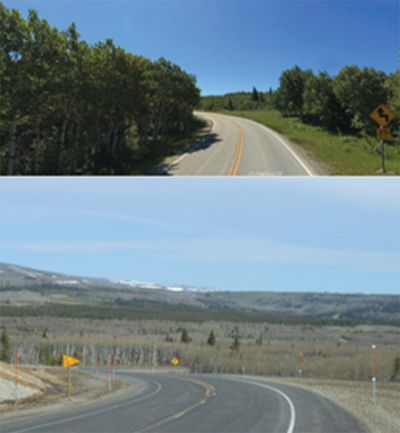← Return to Monthly Spotlight Archives
Local & Rural Road Safety | May 2022
“This project was a successful collaboration with the Department of Transportation, the Blackfeet Tribe, and contractors. A much safer and efficient roadway was constructed with environment and Tribal cultural subjects addressed. A pleasurable driving experience is provided so as to enjoy the beauty of Montana while utilizing innovation engineering and construction principles to deal with weather and geological issues. The Montana Department of Transportation is very proud of this accomplishment and we invite everyone to enjoy our scenic roadways.”
- Jim Wingerter, Great Falls District Administrator

Figure 1. Old (top) vs new (bottom) road alignment.
Source: Montana DOT
Built in 1927, US Highway 89 was not designed for modern traffic demands. The highway, in the area west of Browning, MT, provides a key entrance to Glacier National Park and traverses the Blackfeet Indian Reservation, which is home to numerous culturally important sites. The route was narrow with sharp curves, few turnouts, and experienced heavy tourist traffic. Roadway departure crashes were the predominant crash type. To improve roadway safety while minimizing impacts to numerous Blackfeet cultural sites, adjacent wetlands, and area wildlife, the Montana Department of Transportation (DOT), in close collaboration with the Blackfeet Tribe, a Steering Committee, and an Interdisciplinary Team, performed major road improvements along a 5.8-mile stretch of the highway.
The reconstruction of the 5.8-mile section of US Highway 89 sought to improve 21 curves to current standards, add 6-foot shoulders, and shoulder rumble strips. These improvements provide a comprehensive safety approach to reduce crashes. Additionally, this project implemented many innovative engineering concepts including snow storage design, geotechnical slope stabilization and armoring, and strategically located vehicle pullouts to accommodate tourists wishing to pullover to observe the natural landscapes, vistas, and cultural sites. Collaboration between Montana DOT, Blackfeet Tribe, a Steering Committee, and an Interdisciplinary Team helped determine the preferred alternative. Stakeholder engagement with motorcyclists also identified a need to increase visibility which was accommodated by realigning curves, increasing shoulder width, and increasing clear zones.
Located entirely on the Blackfeet Nation Reservation, this project improves roadway safety while protecting and enhancing the cultural resources for the local population. Using the Highway Safety Manual crash predictive method for rural, two-lane, two-way roads, the new alignment is expected to see a crash reduction of 85.9 percent. While post project safety data is limited, as the final stages of the project will be completed in the Summer of 2022, Montana DOT does intend to conduct a study on the project’s effectiveness in the future. Montana DOT coordinated and collaborated with the Blackfeet Cultural Department to identify and locate culturally significant sites including burial grounds, cloth offering sites, teepee rings, and cairns. Additional benefits of this project include protection of the natural environment and decreased future maintenance costs from winter snow removal operations.
RSPCB Program Point of Contact
Felix Delgado, FHWA Office of Safety
Felix.Delgado@dot.gov
FHWA Office of Safety
Staff and Primary Work Responsibilities
FHWA Office of Safety
Safety and Design Team
FHWA Resource Center